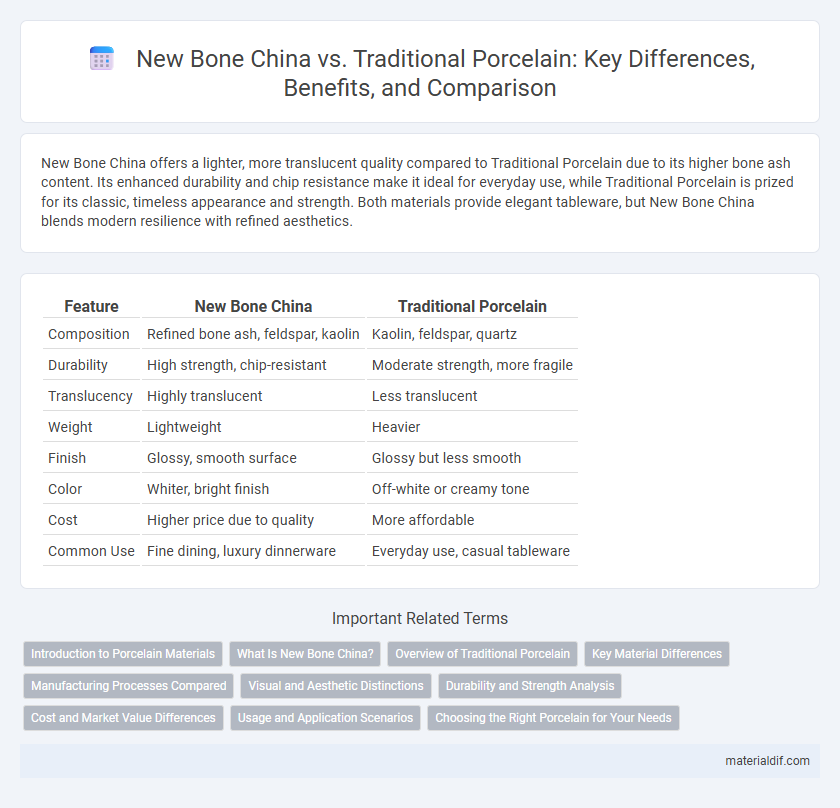New Bone China offers a lighter, more translucent quality compared to Traditional Porcelain due to its higher bone ash content. Its enhanced durability and chip resistance make it ideal for everyday use, while Traditional Porcelain is prized for its classic, timeless appearance and strength. Both materials provide elegant tableware, but New Bone China blends modern resilience with refined aesthetics.
Table of Comparison
| Feature | New Bone China | Traditional Porcelain |
|---|---|---|
| Composition | Refined bone ash, feldspar, kaolin | Kaolin, feldspar, quartz |
| Durability | High strength, chip-resistant | Moderate strength, more fragile |
| Translucency | Highly translucent | Less translucent |
| Weight | Lightweight | Heavier |
| Finish | Glossy, smooth surface | Glossy but less smooth |
| Color | Whiter, bright finish | Off-white or creamy tone |
| Cost | Higher price due to quality | More affordable |
| Common Use | Fine dining, luxury dinnerware | Everyday use, casual tableware |
Introduction to Porcelain Materials
New Bone China combines traditional porcelain's translucency with bone ash, enhancing strength and whiteness compared to Traditional Porcelain made primarily from kaolin, feldspar, and quartz. Bone ash increases calcium phosphate content, resulting in a lighter, more durable material ideal for fine dinnerware and detailed designs. Porcelain's composition significantly impacts its thermal resistance, translucency, and mechanical properties, differentiating New Bone China as premium tableware.
What Is New Bone China?
New Bone China is a refined form of porcelain that incorporates bone ash, resulting in increased whiteness, translucency, and strength compared to traditional porcelain. This material combines kaolin, feldspar, and bone ash, typically sourced from cattle bones, to achieve a delicate yet durable finish ideal for fine tableware and decorative items. Its unique composition makes New Bone China lighter and more chip-resistant while maintaining the elegant appearance associated with high-quality ceramics.
Overview of Traditional Porcelain
Traditional porcelain, known for its high firing temperature around 1300degC, is celebrated for its strength, translucency, and white, glass-like surface. Composed primarily of kaolin, feldspar, and quartz, it achieves a vitrified, non-porous body that is both durable and resistant to thermal shock. Its artisanal production methods have been refined over centuries, making it a benchmark for quality in fine china and ceramic art.
Key Material Differences
New Bone China incorporates a higher percentage of bone ash, typically around 25-30%, which enhances its translucency and strength compared to traditional porcelain that relies mainly on kaolin, feldspar, and quartz. The bone ash in New Bone China contributes to a warmer white tone and increased durability, whereas traditional porcelain often exhibits a cooler, more opaque finish. These key material differences result in New Bone China being lighter and more chip-resistant, making it preferred for fine tableware.
Manufacturing Processes Compared
New Bone China is manufactured by incorporating bone ash into the clay mixture, resulting in a composition that is more translucent and stronger than Traditional Porcelain, which primarily uses kaolin, feldspar, and quartz. The firing temperature for New Bone China is typically lower, around 1,200degC to 1,300degC, compared to Traditional Porcelain's higher range of 1,300degC to 1,450degC, which affects the density and translucency of the final product. This difference in raw materials and firing techniques leads to New Bone China having a smoother texture and greater chip resistance, while Traditional Porcelain maintains superior hardness and a more opaque finish.
Visual and Aesthetic Distinctions
New Bone China exhibits a translucent quality with a warm, ivory hue that distinguishes it from the more opaque and whiter appearance of traditional porcelain. The finer grain and higher kaolin content in New Bone China result in a smoother, glossier surface, enhancing its delicate and refined aesthetic. Traditional porcelain tends to have a heavier, more robust look with a cooler white tone and less translucency, giving it a classic but less luminous appeal.
Durability and Strength Analysis
New Bone China exhibits superior durability and strength compared to traditional porcelain due to its higher calcium content from bone ash, which enhances translucency and resistance to chipping. Traditional porcelain, primarily made from kaolin and feldspar, is more brittle and prone to cracking under stress. The advanced firing process in New Bone China also contributes to a denser, more resilient ceramic body ideal for everyday use.
Cost and Market Value Differences
New Bone China typically commands a higher market value than Traditional Porcelain due to its superior translucency, strength, and refined aesthetic appeal. Manufacturing New Bone China requires more expensive raw materials like bone ash, increasing production costs compared to the feldspar and kaolin used in Traditional Porcelain. Consequently, New Bone China products are often priced higher, targeting premium market segments, while Traditional Porcelain remains popular for its affordability and widespread use.
Usage and Application Scenarios
New Bone China features higher durability and chip resistance compared to traditional porcelain, making it ideal for everyday use in restaurants and households. Traditional porcelain's elegant translucency and refined finish suit decorative items, fine dining, and ceremonial occasions. Both materials excel in heat retention, but New Bone China's enhanced strength supports frequent handling and commercial applications.
Choosing the Right Porcelain for Your Needs
New Bone China offers a lightweight, translucent quality and higher chip resistance compared to traditional porcelain, making it ideal for everyday use and elegant dining settings. Traditional porcelain is denser, more durable under heavy use, and features a classic, opaque finish favored for decorative pieces and formal occasions. Selecting between New Bone China and traditional porcelain depends on prioritizing durability, aesthetic appeal, and specific usage scenarios to ensure the best fit for your needs.
New Bone China vs Traditional Porcelain Infographic

 materialdif.com
materialdif.com